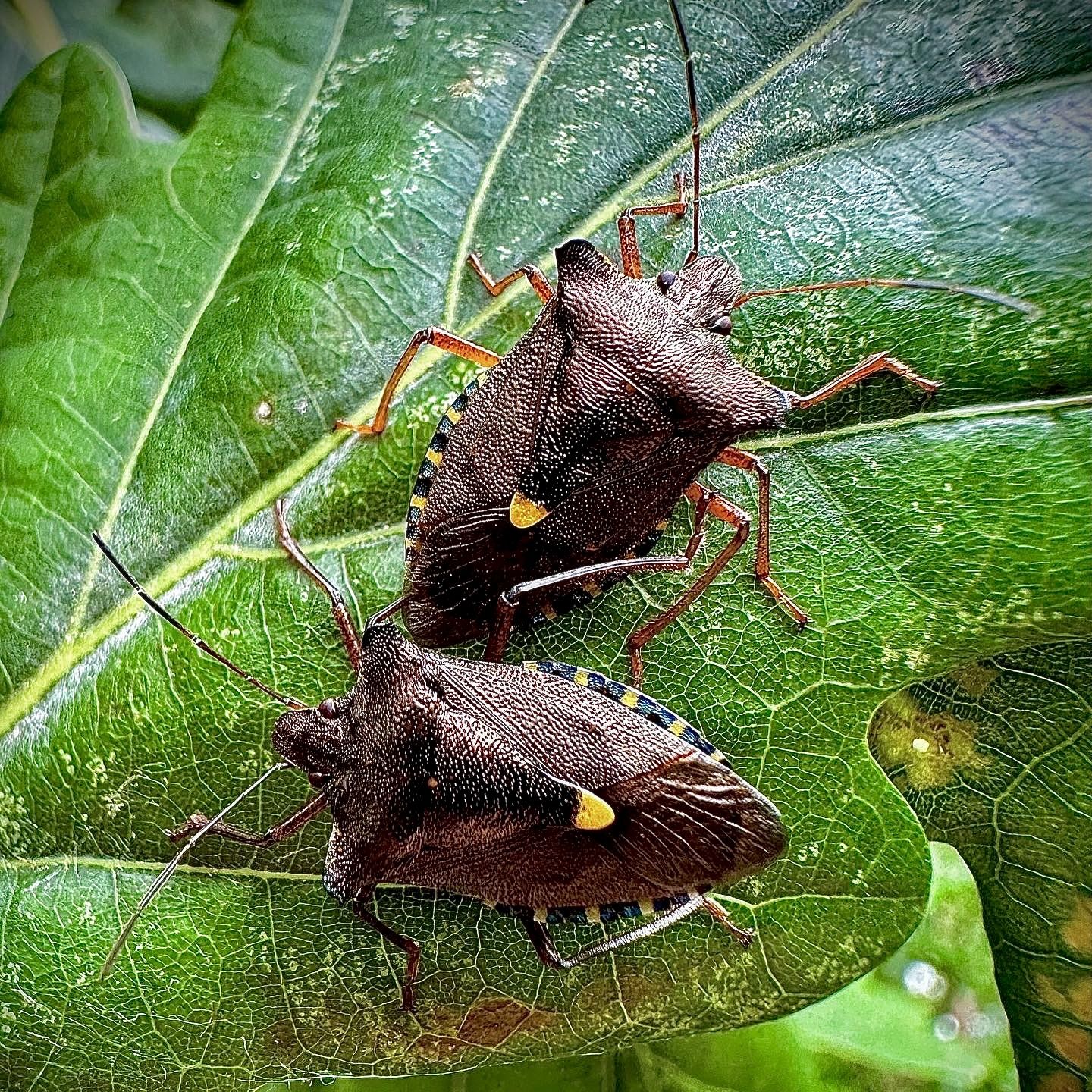BY ANN HAIGH
I AM not sure if this is uncommon or not, but just as many people have favourite foods or colours, I have a fondness for a particular insect—or, more accurately, a group of insects: shieldbugs.
Shieldbugs earn their name from their distinctive adult shape—broad, flat bodies that taper to the rear, resembling a shield.
 Green shieldbug (palomena prasina) eggs spotted in Skibbereen last summer, with their unusual emoji-like appearance. (Photo: Anne Haigh)
Green shieldbug (palomena prasina) eggs spotted in Skibbereen last summer, with their unusual emoji-like appearance. (Photo: Anne Haigh)
They boast a remarkable array of colours and markings, displaying shades of green, blue, red, brown, and orange.
Some exhibit intriguing features, like the hairy shieldbug (dolycoris baccarum) with fine hairs covering their bodies or the spiked shieldbug (picromerus bidens) with spikes adorning their shoulders.
The size varies in our Irish species, from a mere three millimetres in length to a substantial two centimetres.
As a group, they are diverse in appearance, diet, behaviour, and habitat, making them interesting to observe in West Cork.
Occasionally referred to as ‘stinkbugs,’ certain members of the shieldbug group release an odorous liquid as a defence mechanism against predators.
Despite frequently handling them, however, I have seldom detected any odour from these insects.
Not familiar with shieldbugs, or perhaps you’ve heard of them but lack detailed information? Fear not — let me introduce you to these fascinating creatures!
Bugs versus beetles
First things first, it is important to clarify that shieldbugs are true bugs, in the order hemiptera, and are not beetles, which are in the order coleoptera.
One key distinction between the two lies in the anatomy of their mouthparts.
 A pair of forest bugs or red-legged shieldbugs (Pentatoma rufi pes) on an oak leaf seen in Myross Wood. (Photo: Anne Haigh)
A pair of forest bugs or red-legged shieldbugs (Pentatoma rufi pes) on an oak leaf seen in Myross Wood. (Photo: Anne Haigh)
Bugs, such as shieldbugs, aphids, and leafhoppers, possess mouthparts designed for piercing and sucking, whereas beetles like ladybirds and ground beetles have chewing mouthparts.
An aspect that draws me to shieldbugs is their distinctiveness as a group within the bug family.
The shieldbug group has a relatively limited number of members.
This makes it feasible to compile a list and endeavour to identify and observe each species, checking them off one by one. Currently, there are 18 species of shieldbugs and related bug species known in Ireland.
Life cycle
A further difference between beetles and bugs lies in their life cycle.
Shieldbugs bypass the larval stage found in beetles and progress through three main phases: egg, nymph, and adult. Nymphs are miniature, flightless versions of the adult bug.
Typically, there are five nymph stages, referred to as instars, during which the nymphs undergo several moults over a period of six to 10 weeks.
With each moult, they gradually resemble the adult more closely in both form and size. Only the final instar, or the adult stage, possesses wings and is capable of flight.
Exceptional eggs
Another factor that solidifies shieldbugs as my favourite insects is their eggs.
Usually laid in clusters, the eggs of some common species exhibit a remarkable ornateness upon closer inspection.
For instance, the eggs of the gorse shieldbug (piezodorus lituratus) resemble tiny black and white barrels with a distinct spot at the top and a stripe around the middle.
Even more unusual and striking are the eggs of the common green shieldbug (palomena prasina), which sport a pale green coloration and, as the nymphs develop inside, feature what appears to be a smiling emoji face on their tops.
It is hard not to fall in love with any aspect of nature that seemingly possesses a ‘face’.
When and where to find them
As shieldbugs typically hibernate as adults during the winter months, it is theoretically possible to encounter them at any time of the year.
However, they tend to become more active in early spring, as they emerge to breed, with their activity peaking from May to August. Nymphs may begin to emerge from eggs as early as April.
Many shieldbugs are herbivorous, using their pointed mouthparts to feed on sap from various plants.
Consequently, they are commonly found on vegetation and plants.
Certain shieldbug species exhibit preferences for specific plants: for instance, the gorse shieldbug primarily inhabits gorse bushes and the dock bug on dock leaves, while the hawthorn and birch shieldbugs are often associated with their respective namesake trees.
On the other hand, some shieldbug species are carnivorous predators, such as the bronze shieldbug (troilus luridus) or the spiked shieldbug.
These predators can be found wherever their insect prey resides.
They are known to actively hunt and capture small beetles or extract nutrients from dead caterpillars and other soft-bodied insects.
Fascinating behaviour
If I haven’t yet convinced you of the merits of shieldbugs, here’s another appealing feature: a particular Irish species of shieldbug, the parent shieldbug, stands out for its unique behaviour.
It is one of the few insects that display parental care for its offspring. Female parent shieldbugs lay their eggs on the foliage of birch or alder trees, standing guard to protect them from potential predators.
This nurturing instinct helps shield the eggs from other hungry insects.
Once the eggs hatch, the nymphs stick together as a family unit, with the mother bug sticking around until they’re about half-grown.
It is a level of parental involvement that is not common in the insect world, where most species simply lay their eggs and let nature run its course.
Set yourself a challenge
Shieldbugs play a role in the food web and ecosystem and they are preyed on by birds.
As I have, you might even spot their remains caught in spider webs. Overall, they’re a fascinating group to observe.
The National Biodiversity Data Centre website offers a free poster of the 18 species found in Ireland, so why not challenge yourself to spot as many shieldbug species as you can this spring and summer?







